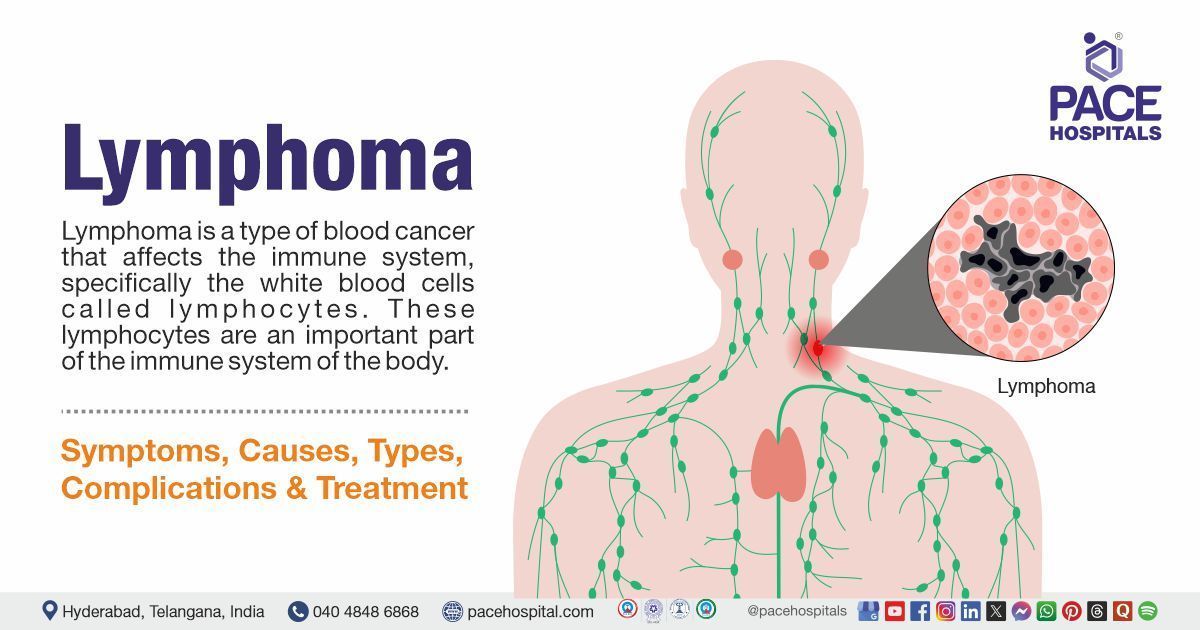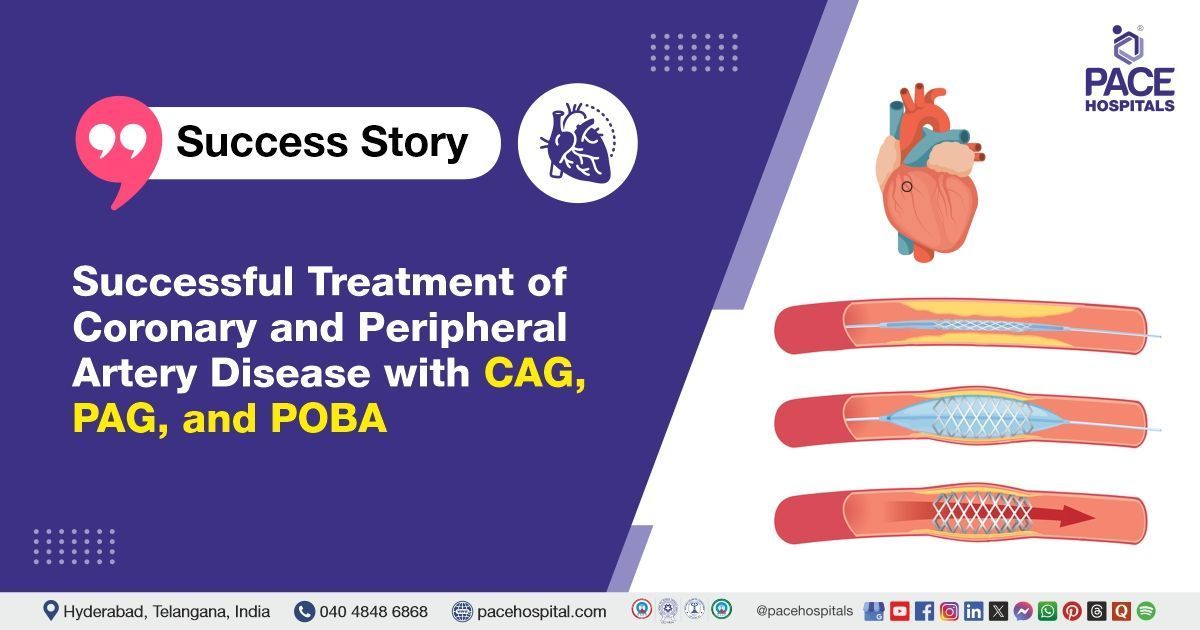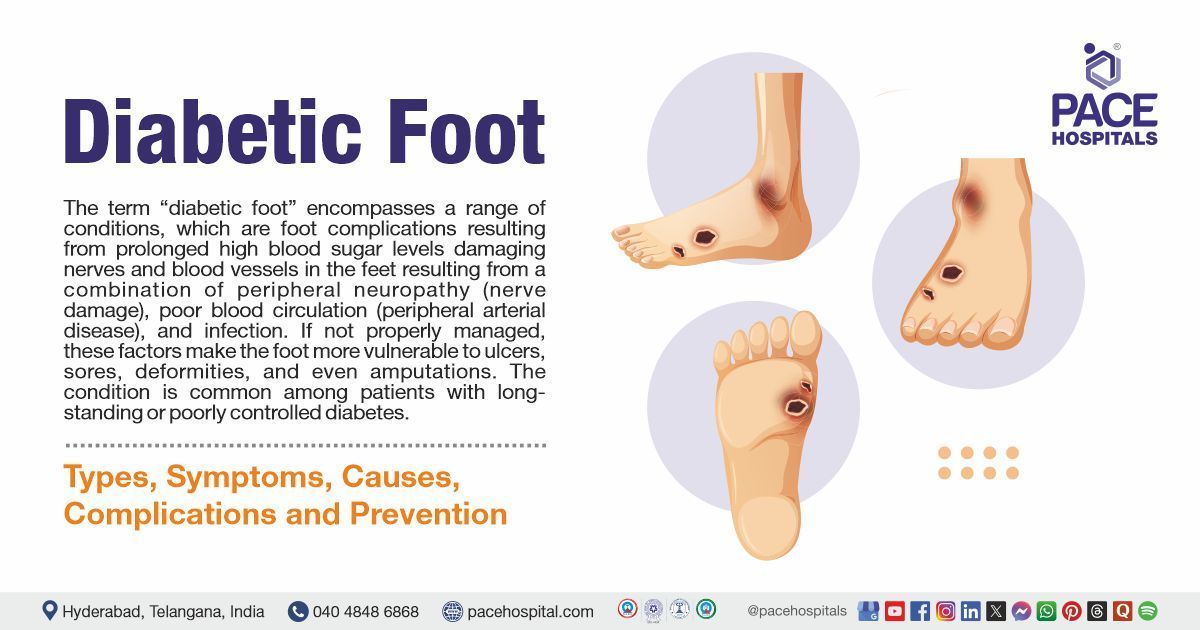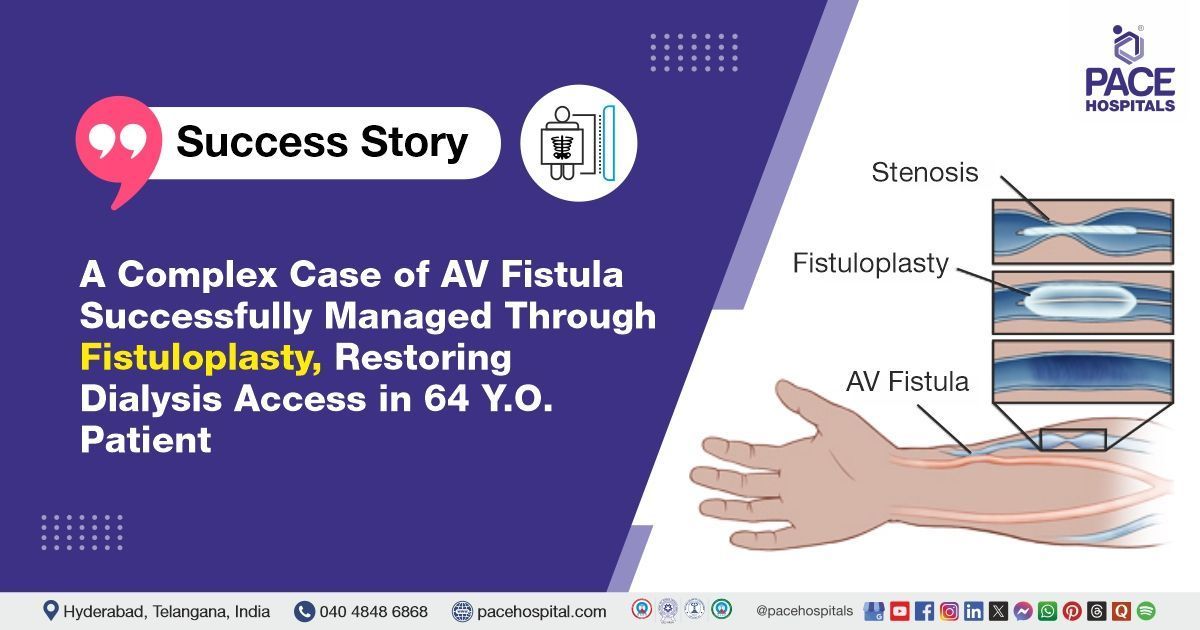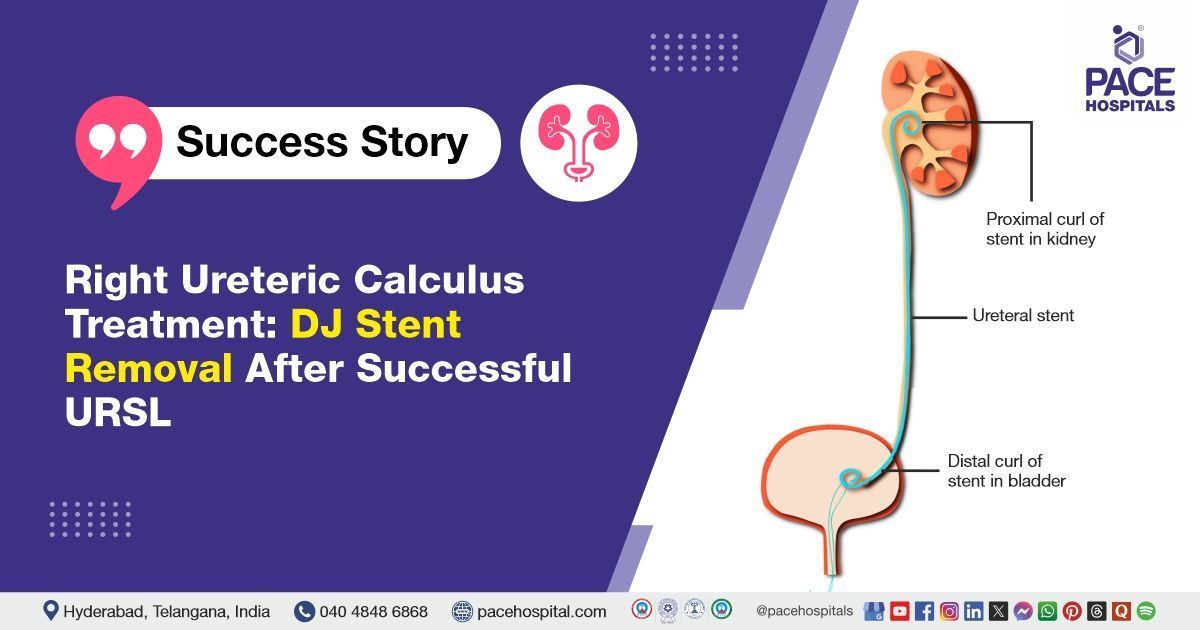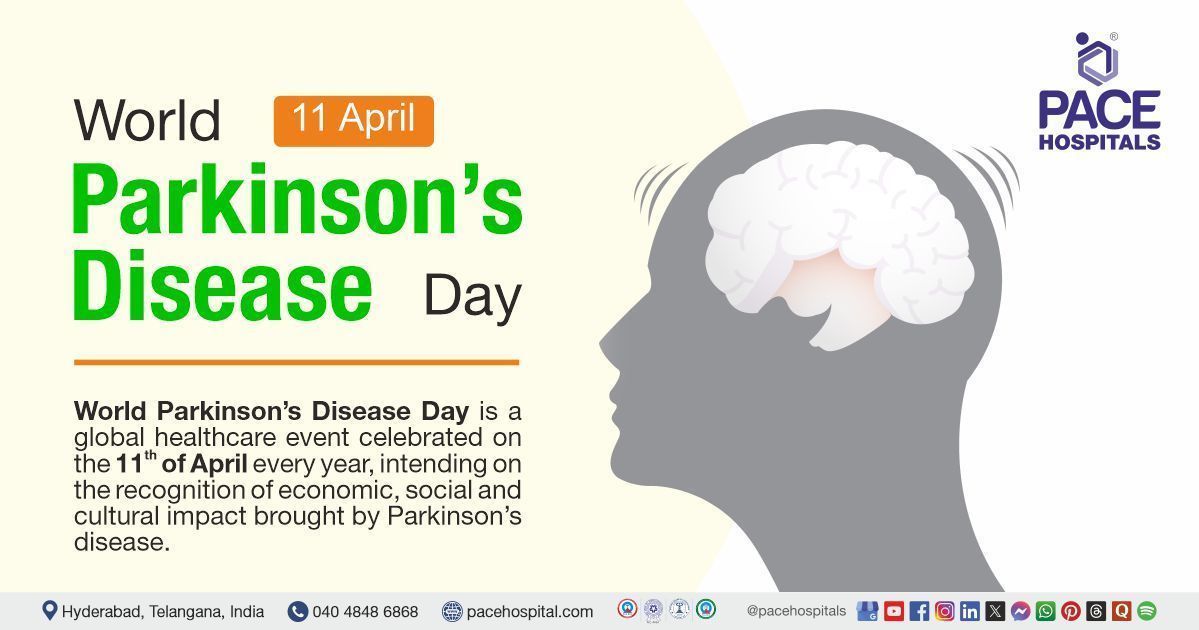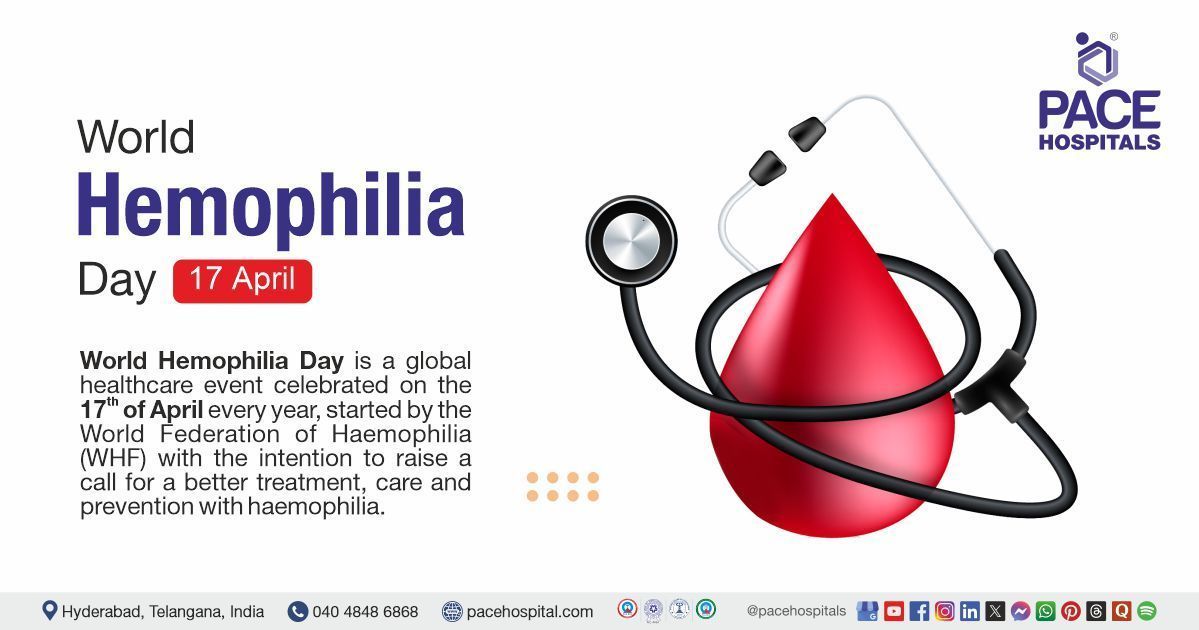Lymphoma: Symptoms, Causes, Types, Diagnosis, Treatment & Prevention
Lymphoma definition
Lymphoma is a type of blood cancer that affects the immune system, specifically the white blood cells called lymphocytes. These lymphocytes are an important part of the immune system of the body. Lymphoma has primarily two main types: Hodgkin lymphoma and non-Hodgkin lymphoma. There is no exact known cause of lymphoma but there are a few factors such as age, sex, family history, and low immunity which can increase the risk of development of lymphoma.
Swollen lymph nodes in the neck, armpits, or groin, fever, weakness and fatigue, weight loss, and sweating are some of the symptoms of lymphoma. Medical oncologists, radiation oncologists, hematologists, and hematopathologists can treat lymphoma.
Lymphoma meaning
The term lymphoma comprises of two words: lymph and oma
The term lymph is derived from the French “lymphe,” from the Latin “lympha” which means water, clear water, a goddess of water. In physiology, lymph refers to a colorless fluid found in animal bodies.
The term oma is derived from Greek -oma, especially taken in medical use to indicate morbid growth or a tumor.
Lymphoma statistics
Lymphoma statistics worldwide
According to the GLOBOCAN studies, the incidence and mortality of Hodgkin lymphoma were 0.98 and 0.26 per 100,000 in 2020. A high incidence was observed in high-income countries, while higher mortality was seen in low-income countries.
Non-Hodgkin lymphoma ranks as the 5th to 9th most common cancer globally, with an estimated 544,000 new cancer cases and 260,000 cancer deaths in 2020. The highest age-standardized incidence rates for both males and females (per 100,000) were observed in Australia and New Zealand (12.5) and North America (12), while the lowest rates of incidence were in South-Central Asia (2.7).
Lymphoma statistics India
The number of newly diagnosed lymphomas in India in 2020, was 11,230 for Hodgkin lymphoma and 41,607 for non-Hodgkin lymphoma (NHL). The age-standardized incidence and mortality ratio in low or medium High Development Index (HDI) countries is 4.0/2.5 for men and 2.8/1.7 for women per 100,000 population.

Types of lymphoma
Lymphoma occurs when immature lymphocytes start multiplying rapidly because of a genetic mutation or other alteration. This leads to tumors in the lymph nodes or other organs. Lymphomas are of two main types: non-Hodgkin lymphoma (NHL) and Hodgkin lymphoma (HL). However, within these two broad categories, there are more than 90 different subtypes of lymphoma. The following are the types of lymphoma:
- Non-Hodgkin lymphoma: It is the most common form of lymphoma and accounts for about 90 percent of diagnosed lymphomas. Non-Hodgkin lymphoma is more likely to occur in older individuals but can also occur at any time. These are divided further into two categories: B-cell lymphomas and T-cell lymphomas. B-cell lymphomas are far more common and occur in about 80 percent of patients with non-Hodgkin lymphoma. B-cell and T-cell lymphomas include different subtypes. Some of Non-Hodgkin lymphoma are aggressive, requiring immediate treatment but there are some slow-growing types of non-Hodgkin lymphoma which can be watched for years without any treatment.
Examples of B-cell lymphomas:
- Diffuse large B-cell lymphoma: It is the most common type of non-Hodgkin lymphoma, and it is a type of cancer which affects B cells, which is a type of white blood cell.
- Burkitt lymphoma: It is a fast growing and an aggressive form of non-Hodgkin lymphoma that affects B lymphocytes.
- Primary mediastinal B cell lymphoma: It is a type of non-Hodgkin lymphoma which is sometimes called primary thymic mediastinal lymphoma and develops when B-cells become abnormal (cancerous).
- Mantle cell lymphoma: It is a rare type of B cell non-Hodgkin lymphoma, and it results from cancerous B-lymphocytes in the ‘mantle zone’ of lymph nodes, which is a ring of lymphocytes which surrounds the certain structures inside lymph nodes.
- Marginal lymphoma: It is a rare type of non-Hodgkin lymphoma which develops from chronic inflammation or because of a random error in DNA which can lead to the creation of abnormal cells.
- Post-transplant lymphoproliferative disorder: It is a rare, well-known complication of solid organ transplants and stem cell transplantation. And it is related to the Epstein-Barr virus and immunosuppression therapy.
Examples of T cell lymphoma
- Anaplastic large cell lymphoma: It is a rare form of non-Hodgkin lymphoma which is usually made up of either malignant T-cells (a type of cells in the immune system), or ‘null-lymphocytes’ (they lack both B and T-cell markers).
- Angioimmunoblastic lymphoma: This is an aggressive forms of peripheral T-cell lymphoma. It is one of the more common subtypes of T-cell lymphomas and elderly patients are more likely to be diagnosed with this type of lymphoma.
- Extra nodal NK/T-cell lymphoma: This lymphoma is a rare subtype of non-Hodgkin lymphoma and commonly present with a nasal mass, nasal obstruction, or nasal bleeding.
- Peripheral T cell lymphoma not otherwise specified: It is a diverse group of aggressive lymphomas that develop from mature-stage white blood cells called T-cells and natural killer (NK) cells.
- Hodgkin lymphoma: It is also known as Hodgkin’s lymphoma or Hodgkin disease which occurs in only 10 percent of the lymphoma patients. It is diagnosed when the patient has mutated cells called Reed-Sternberg cells and it occurs more commonly in young individuals. This lymphoma is a highly treatable form, and many patients can be cured. Chemotherapy is primarily used as an initial treatment. If Hodgkin's lymphoma recurs, stem cell transplants coupled with high-dose chemotherapy can be used and are effective at eliminating the disease. Hodgkin lymphoma is primarily of two main types:
- Classical lymphocyte predominant: It is characterized by the presence of both Hodgkin and Reed Stenberg cells. About 95 percent of patients with Hodgkin lymphoma have classical lymphocyte predominant type
- Nodular lymphocyte predominant: This type of lymphoma accounts for about 5 percent of Hodgkin lymphoma patients. It affects people aged between 30 to 50 years old.
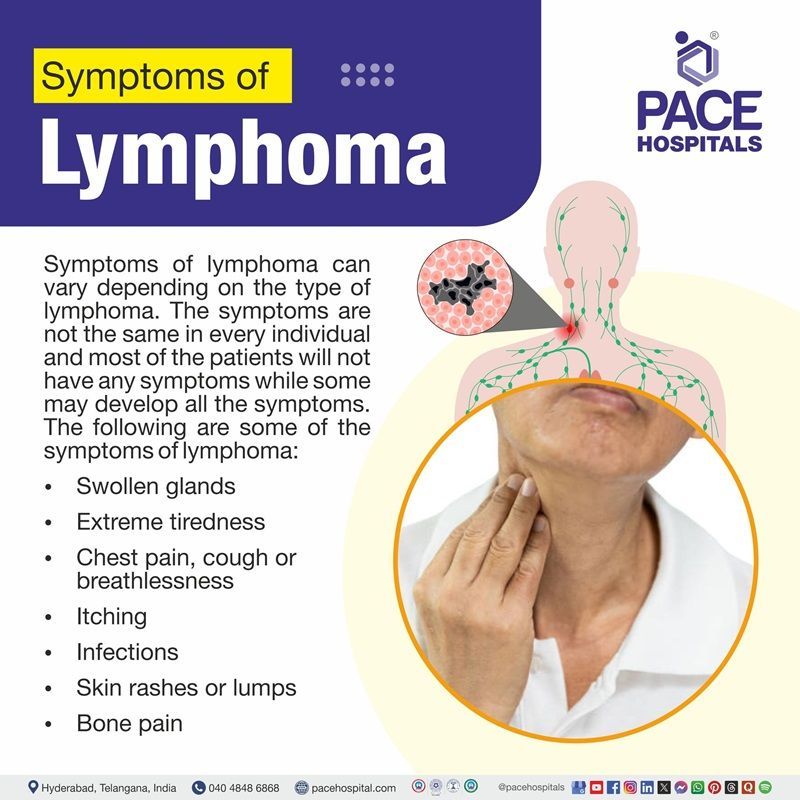
Lymphoma symptoms
Symptoms of lymphoma can vary depending on the type of lymphoma. The symptoms are not the same in every individual and most patients will not have any symptoms while some may develop all the symptoms.
Common lymphoma symptoms
The common symptoms of lymphoma are listed below:
- Swollen glands
- Extreme tiredness
- Chest pain, cough or breathlessness
- Feeling uncomfortably full or sick
- Itching
- Infections
- Skin rashes or lumps
- Bone pain
- Unusual bleeding or bruising
Other symptoms of lymphoma
Waldenstrom macroglobulinemia is a type of lymphoma which causes the following symptoms:
- Headaches and dizziness
- Confusion
- Blurred vision
- Kidney problems
- Nose bleeds
- Numbness in the legs and feet.
Lymphoma risk factors
Different environmental, infections, and genetic factors have been identified which can increase the risk of lymphoma. The following are some of the common risk factors of lymphoma:
- Older age: With increasing age the risk of developing lymphoma also increases. Older individuals are more likely to develop lymphoma, particularly non-Hodgkins’s lymphoma. Due to a weak immune system and other co-morbidities, the prognosis of lymphoma is poor in older patients.
- Occupational exposure: Exposure to chemicals such as herbicides and pesticides can significantly increase the risk of developing lymphoma. These chemicals contain carcinogenic agents which damage the immune system and cause mutations in lymphocytes.
- Infectious organisms: Organisms such as Helicobacter pylori, Borrelia burgdorferi, Chlamydia psittaci, Campylobacter jejuni, human T-cell lymphotropic virus, hepatitis C & human herpesvirus 8 can increase the risk of developing lymphoma.
- Immunodeficiency: In individuals with HIV infection, transplant recipients, and those with genetic immunodeficiency disorders, the risk of developing lymphoma is high.
- Drugs: Tumour necrosis factor-alpha inhibitors are linked with T-cell lymphoma. The risk of lymphoma increases in post-transplant patients (both in recipients of solid organ transplants and bone marrow transplant) with chronic immunosuppression.
- Autoimmune disease: Inflammatory bowel disease (IBD), rheumatoid arthritis, and Sjögren’s syndrome are some of the autoimmune diseases that increase the risk of lymphoma development.
- Geographic location: In Southern Asia and some parts of Latin America the incidence of Extra nodal Natural Killer /T-cell lymphoma is high.

Complications of lymphoma
Like all cancers, lymphoma can cause a wide range of side effects and complications. The following are the complications of lymphoma:
Complications of Hodgkin’s lymphoma
Hodgkin lymphoma occurs when the patient develops mutant cells called Reed-Sternberg cells. The following are the complications of Hodgkin lymphoma:
- Paraneoplastic syndromes: It occurs when the immune system, in addition to attacking cancer cells, starts attacking the normal healthy cells of the nervous system, including parts of the brain, spinal cord, peripheral nerves, or muscles. They include:
- Limbic encephalitis: It is a rare autoimmune disease which causes inflammation of the brain. Few cases of limbic encephalitis are associated with Hodgkin lymphoma, and it causes symptoms such as memory loss, psychiatric symptoms, and confusion.
- Primary CNS angiitis: It is a rare disease that causes inflammation of blood vessels in the brain and spinal cord. This condition is also known as primary central nervous system vasculitis.
- Cerebellar degeneration: It is a process where neurons (nerve cells) in the cerebellum—the area of the brain that controls coordination and balance start to deteriorate and die.
- POEMS Syndrome: It is a rare blood disorder which affects the nerves and other various parts of the body. It is characterized by the following:
- Polyneuropathy: It is a diffuse peripheral nerve disorder which is not confined to the distribution of a single nerve or single limb and typically affects both sides symmetrically.
- Organomegaly: It is defined as an abnormal enlargement of an organ, particularly organs of the abdominal cavity such as the liver (hepatomegaly), spleen (splenomegaly), and other organs.
- Endocrinopathy: It is a central feature of POEMS syndrome and refers to diseases which affects the endocrine gland and its hormones.
- Monoclonal plasma cell disorder: It is a group of diseases which occur when plasma cells multiply abnormally producing a monoclonal antibody called M protein.
- Skin changes: In about 50 to 90 percent of POEMS syndrome patients’ hyperpigmentation occurs. Along with this, skin thickening and tightening are also reported.
Complications of non-Hodgkin’s lymphoma
This is the most common form of lymphoma and accounts for about 90 percent of the lymphomas diagnosed. Non-Hodgkin lymphoma and its treatments cause a wide range of complications. The following are some of the complications:
- Weakened immune system: Treatment of non-Hodgkin lymphoma causes the immune system to weaken, and this weakening is called immunosuppression. It is important to be extra careful to avoid infections because infections can be serious in immunosuppressed patients.
- Fertility problems: Some of the cancer treatments can affect fertility in patients and these effects can be temporary or permanent.
- Secondary cancer: Patients with lymphoma have an increased risk of developing secondary cancers and this risk depends on the type of lymphoma. Radiotherapy during lymphoma treatment can also increase the risk of secondary cancers.
- Organ damage: Both chemotherapy and radiotherapy can cause long-term damage to organs such as hearts and lungs. They can damage the nerves, causing symptoms such as tingling, numbness or pain.
Complications of chemotherapy for lymphoma
Complications associated with chemotherapy are as follows:
- Pancytopenia: It is a condition in which the levels of all blood types such as red blood cells, white blood cells, and platelets drop. It occurs due to the suppression of blood cell production during chemotherapy.
- Cardiomyopathy: In Hodgkin lymphoma patients there is always an increased risk for cardiovascular morbidity and mortality related to the long-term cardiotoxicity of treatment, particularly chemotherapy and radiotherapy.
- Pneumonitis: Pneumonitis affects 15 to 40 percent of patients who have undergone radiation therapy for lung cancer. It can also develop in patients who have undergone chest radiation for treating lymphoma.
- Neuropathy: Both chemotherapy and radiation therapy-induced neuropathies are common in lymphoma patients. Long-term cancer survivors usually have an unavoidable tissue trace of their previous treatment, especially radiotherapy which is often clinically asymptomatic.
- Acute myeloblastic leukemia: With radiation therapy the risk of developing acute myeloblastic leukemia is high. Radiation directly damages DNA, causing mutations that either prevent a cell from maturing or cause the proliferation of cells beyond normal.
Complications of radiotherapy for lymphoma
- Pericardial fibrosis: It is a condition where the pericardium which is the sac around the heart thickens or scars. Radiotherapy related to pericardial fibrosis is common and radiation causes fibrosis of all the heart components and increases the risk of various heart conditions.
- Lung cancer: Radiation-induced lung cancer is the potential long-term complication of radiotherapy. Lung cancers are rare late complications of radiation therapy in both post-operative breast cancer and Hodgkin lymphoma patients.
- Thyroid cancer: During radiotherapy, the thyroid gland absorbs too much radioactive iodine which may result in thyroid cancer. The radiation dose supplied to the thyroid gland and the age of exposure are the risk factors for thyroid cancer.
- Breast cancer: Lymphoma patients face a higher risk of breast cancer, and the risk increases over time in lymphoma patients. Many research studies have indicated that radiation therapy used in the treatment of lymphoma causes long-term damage to breast tissue, which leads to an increased chance of developing cancer.
- Soft tissue sarcomas: Individuals who have undergone radiation therapy as a treatment for another cancer usually have a risk of developing soft tissue
sarcoma. This risk is particularly high for Hodgkin lymphoma and non-Hodgkin lymphoma patients who received radiation therapy.
Lymphoma diagnosis
Diagnosis of lymphoma helps in understanding the type of lymphoma, how advanced it is, and helps in deciding which type of treatments will be most effective. The following are the steps involved in the diagnosis of lymphoma:
Initial diagnosis
- Medical history
- Physical examination
Diagnostic tests
- Blood tests
- Complete blood count (CBC)
- Erythrocyte sedimentation rate (ESR)
- Lactate dehydrogenase (LDH)
- Blood smear
- Testing for certain viruses
- Other blood tests
- Biopsy techniques
- Bone marrow biopsy
- Lymph node biopsy
- Imaging studies
- X-ray
- Computed Tomography (CT) scan
- Magnetic resonance imaging (MRI) scan
- Ultrasound
- Positron emission tomography (PET)
Lymphoma treatment
Treatment of lymphoma depends on factors such as age, general health of the patient, type of lymphoma, and whether the cancer has spread to other parts of the body. The following are the steps involved in treating lymphoma:
- Bone marrow transplantation (BMT)
- Chemotherapy
- CAR T-cell therapy
- Immunotherapy
- Radiation therapy
- Targeted therapy
- Monoclonal antibody therapy
Lymphoma prevention
There is no proven way of preventing lymphoma but as lymphoma affects the immune system, there are steps that can be taken to prevent it, such as reducing the risk of contracting infections and making lifestyle changes which helps in maintaining a healthy immune system. The following are some of the measures to reduce the risk of lymphoma:
- Physical activity: It is important for both the physical and mental health of the individual. It reduces fatigue and increases muscle strength and improves balance.
- Diet: Including diets rich in fruits, vegetables, and whole grains reduces the risk of developing lymphoma. Avoiding foods such as processed meat and high energy foods can improve health.
- Avoiding smoking: Smoking is one of the potential risk factors for developing lymphoma. Therefore, smoking cessation can reduce the risk of developing late effects after treatment.
- Maintaining body weight: Maintaining a healthy weight is a part of leading a healthy lifestyle. To reach a healthy weight, people need to reduce food consumption and increase physical activity. Reducing daily calorie intake trying to decrease portion size at every meal and limiting the number of snacks throughout the day.
- Avoiding contracting infections: Avoiding known risk factors for HIV, such as intravenous drug use or unprotected sex with multiple partners can reduce the risk of contracting infections.
Difference between Hodgkin’s lymphoma vs non-Hodgkin’s lymphoma
Hodgkin’s lymphoma vs non-Hodgkin’s lymphoma
Both Hodgkin and non-Hodgkin lymphoma are the two main types of lymphoma which affects the lymphatic system. Though they have many common characteristics, they differ in many aspects. The following are some of the parameters which differentiate Hodgkin and non – Hodgkin lymphoma:
| Parameters | Hodgkin lymphoma | Non-Hodgkin Lymphoma |
|---|---|---|
| Age group | It commonly affects adolescents and young adults and those over the age of 60. | It is more commonly seen in individuals over the age of 60. |
| Origin | It starts with lymph nodes of the upper body which includes the head, neck, chest, and armpits. | It begins in lymph nodes throughout the body and sometimes can begin outside of lymph nodes. |
| How it spreads | It progresses from one lymph nodes to the next and rarely reaches other organs until the later stages of the disease. It is diagnosed at an early stage. | It spreads more randomly, and the majority of the patients are diagnosed at a more advanced stage. |
| Subtypes | Hodgkin lymphoma is of two types: classical predominant and nodular lymphocyte predominant Hodgkin lymphoma. | It includes more than 60 types which are again divided into two main groups: B-cell and T-cell cancers. |
Difference between Leukemia vs lymphoma
Leukemia vs lymphoma
Both leukemia and lymphoma are blood cancers which can originate in different parts of the body and can affect different types of white blood cells. The following are some of the key parameters which differentiate leukemia and lymphoma:
| Parameters | Leukemia | Lymphoma |
|---|---|---|
| Definition | It is a cancer of blood cells which begins in blood-forming tissues such as bone marrow. | It is a type of blood cancer which affects the immune system, specifically the white blood cells (WBC) called lymphocytes, these lymphocytes are an important part of the immune system of the body. |
| Causes | Changes or mutations in the genetic material (DNA) in bone marrow cells results in leukemia. | There is no exact known cause of cancer but there are a few factors such as age, occupational exposure, and infections which can increase the risk of lymphoma. |
| Symptoms | Feeling tired, fatigue, easy bruising, bleeding, and weight loss are some of the common symptoms of leukemia. | Swollen glands, extreme tiredness, chest pain, cough or breathlessness, itching, bone pain, skin rashes or lumps, infections, unusual bleeding or bruising. |
| Treatment | Treatment includes chemotherapy, radiotherapy, targeted therapy, and chemotherapy with stem cell transplant. | Treatment involves chemotherapy, radiotherapy, bone marrow transplant, monoclonal antibodies, and targeted drug therapy. |
Frequently Asked Questions (FAQs) on Lymphoma
Is lymphoma cancer curable?
In general, lymphoma is curable, however, treatment is based on several factors, most notably the type of lymphoma, the severity of the condition, and how early the cancer was detected. Early-stage Hodgkin’s lymphoma usually responds well to treatment and has a high cure rate.
Is lymphoma hereditary?
Lymphoma is not directly inherited from a parent or other family member. However, a family history of lymphoma increases the risk, when an individual has a family history of lymphoma, they are at three to four times more likely to develop certain types of non-Hodgkin lymphoma such as diffuse large B-cell lymphoma, follicular lymphoma, and plasma cell myeloma.
Which is the advanced stage of lymphoma?
In stage IV lymphoma, cancer has spread widely to at least one organ outside the lymph system such as the bone marrow, the liver, or lungs. Stage IV lymphoma is considered as the advanced stage of lymphoma.
Is lymphoma detected in blood tests?
Blood tests alone cannot detect lymphoma but can help in diagnosing and understanding the condition. These blood tests may include a complete blood count (CBC), liver and kidney function test, human immunodeficiency virus (HIV), and hepatitis testing. CBC may help in measuring the amount of red blood cells, white blood cells, and platelets. A low count of these cells may indicate the presence of lymphoma. kidney and
Liver function tests may help in knowing if the lymphoma has spread to the liver or kidneys.
Can ultrasound detect lymphoma?
Ultrasound is used to look at lymph nodes that are near the surface of the body or to look inside the abdomen for enlarged lymph nodes or organs such as the liver and spleen. It can also detect if kidneys that have become swollen due to the outflow of urine is blocked by enlarged lymph nodes.
Can complete blood picture detect lymphoma?
Complete blood count (CBC) cannot directly diagnose lymphoma, but it helps in measuring the number of blood cells in a sample, including red blood cells (RBC), white blood cells (WBC), and platelets. A low level of red blood cells, white blood cells or platelets may indicate that lymphoma is present in the bone marrow or blood.
How long can lymphoma go undiagnosed?
Lymphoma can remain undiagnosed for a long period of time. Certain types of lymphoma called low-grade lymphoma grow very slowly and don’t cause symptoms such as fever, infections, and night sweats. Due to this, non-Hodgkin lymphoma can goes undiagnosed for a long time, making it difficult to treat.
How to treat diffuse large b cell lymphoma?
Lymphoma is treated with chemoimmunotherapy. Treatment usually involves chemotherapy with monoclonal antibodies. The most widely used treatment is a combination known as R-CHOP which is usually given in cycles of 21 days, for an average of 6 cycles.
Chest X-ray is the primary imaging study used in the diagnosis of lymphoma. It is performed to detect the presence of enlarged lymph nodes in the chest region. Patients with Hodgkin lymphoma generally have mediastinal lymph node enlargement which is visible on chest X-rays.
A biopsy is the most important test for diagnosing lymphoma. There are different types of biopsy procedures but as most lymphomas affect the lymph nodes, the common place to take a biopsy sample from is an enlarged lymph node. In this procedure, a sample is taken from the lymph node and examined under a microscope for the presence of lymphoma.
How does MRI help in diagnosing lymphoma?
Magnetic resonance imaging (MRI) provides detailed information about the internal tissues and organs, especially the nervous system. By using this imaging study, clear and detailed images of bones, brain, and spinal cord are obtained and therefore it is recommended for diagnosing lymphoma to detect the spread of lymphoma in the bones, brain, and spinal cord.
What is CAR T cell therapy in lymphoma?
It is a type of treatment which uses cells from the patient’s own immune system to fight lymphoma. With CAR-T cell therapy, some of the T cells from the patient’s immune system are collected and sent to a lab where they are changed (genetically modified) in order to recognize and stick to a particular protein on the surface of the patient’s lymphoma cells.
The changed T cells are known as ‘CAR-T cells and CAR stands for ‘chimeric antigen receptor’. These cells, when grown sufficiently to treat lymphoma cells, are transferred via blood transfusion to the patient. They stick to the lymphoma cells, and the CAR-T cells are activated and start killing the lymphoma cells.
Request an appointment
Fill in the appointment form or call us instantly to book a confirmed appointment with our super specialist at 04048486868
Appointment request - health articles
Thank you for contacting us. We will get back to you as soon as possible. Kindly save these contact details in your contacts to receive calls and messages:-
Appointment Desk: 04048486868
Whatsapp: 8977889778
Regards,
Pace Hospitals
Hitech City and Madinaguda
Hyderabad, Telangana, India.
Oops, there was an error sending your message. Please try again later. We will get back to you as soon as possible. Kindly save these contact details in your contacts to receive calls and messages:-
Appointment Desk: 04048486868
Whatsapp: 8977889778
Regards,
Pace Hospitals
Hitech City and Madinaguda
Hyderabad, Telangana, India.
Our Locations – Find the Best Hospital Near You
Metro Pillar Number C1772, Beside Avasa Hotel, Hitech City Road, Near HITEC City Metro Station, Hyderabad, Telangana, India.
Mythri Nagar, Beside South India Shopping Mall, Hafeezpet, Madeenaguda, Hyderabad, Telangana, India.
040 4848 6868
Payment in advance for treatment at PACE Hospitals, Hyderabad, Telangana, India (Pay in INR ₹)
For Bank Transfer:-
- Bank Name: HDFC
Company Name: Pace Hospitals
A/c No.50200028705218
IFSC Code: HDFC0000545 - Bank Name: STATE BANK OF INDIA
Company Name: Pace Hospitals
A/c No.62206858997
IFSC Code: SBIN0020299
Scan QR Code by Any Payment App (GPay, Paytm, Phonepe, BHIM, Bank Apps, Amazon, Airtel, Truecaller, Idea, Whatsapp etc).

CONTACT US
Call: +914048486868
WhatsApp: +918977889778
Email: info@pacehospitals.in
FOLLOW US
SUBSCRIBE
Subscribe to our newsletter and stay updated with the latest health information.
Subscribe to PACE Hospitals' Public Newsletter
Thank you for subscribing to PACE Hospitals' Newsletter. Stay updated with the latest health information.
Oops, there was an error. Please try again submitting your details.
ABOUT US
QUICK LINKS
Disclaimer
General information on healthcare issues is made available by PACE Hospitals through this website (www.pacehospital.com), as well as its other websites and branded social media pages. The text, videos, illustrations, photographs, quoted information, and other materials found on these websites (here by collectively referred to as "Content") are offered for informational purposes only and is neither exhaustive nor complete. Prior to forming a decision in regard to your health, consult your doctor or any another healthcare professional. PACE Hospitals does not have an obligation to update or modify the "Content" or to explain or resolve any inconsistencies therein.
The "Content" from the website of PACE Hospitals or from its branded social media pages might include any adult explicit "Content" which is deemed exclusively medical or health-related and not otherwise. Publishing material or making references to specific sources, such as to any particular therapies, goods, drugs, practises, doctors, nurses, other healthcare professionals, diagnoses or procedures is done purely for informational purposes and does not reflect any endorsement by PACE Hospitals – your trusted hospital near me.

